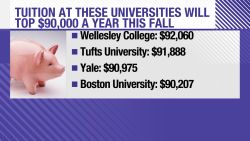Even by Uber’s standards, the company burned through a staggering amount of money in its most recent quarter.
Uber (UBER) said Thursday that it lost $5.2 billion in the three months ending in June, its largest quarterly loss ever, fueled mostly by $3.9 billion in stock-based compensation expenses related to its public offering during the quarter.
Without those charges, however, the company still lost about $1.3 billion during the quarter, a roughly 50% spike from the year prior. The mounting losses come as Uber continues to invest in freight shipping, meal deliveries and offering discounts for its core ride-hailing business to attract new customers and compete with companies like Lyft (LYFT).
“There’s the meme [going] around, which is, can Uber ever be profitable?” Dara Khosrowshahi, Uber’s CEO, said on a conference call with analysts Thursday after the earnings report. “I’ve certainly heard that meme, along with others.”
Khosrowshahi stressed that Uber’s ride-hailing service, along with its meal delivery service, each have the potential to “be a spectacular business long-term.”
But even as it invests aggressively, Uber’s revenue growth continues to slow. The company posted revenue of $3.1 billion during the quarter, a 14% increase from the year prior — hardly the rocket ship growth that investors typically expect from newly public technology firms.
Uber’s core ride-hailing business was all but flat. Revenue in this sector ticked up just 2% from the same quarter a year ago. Uber Eats, its meal delivery service, continues to be a bright spot, with revenue growing 72% from the prior year. But it accounted for only a modest percentage of Uber’s overall business.
Shares of Uber fell by as much as 12% in after hours trading Thursday following the disappointing earnings report, before rebounding somewhat. Uber’s stock had rallied earlier on Thursday, ending the day up more than 8%, after rival Lyft updated its forecast for the year to indicate faster than expected revenue growth and narrower than expected losses.
For years, Uber was viewed as the darling of Silicon Valley. It raised unprecedented sums of private capital, bulldozed ahead of ride-hailing rivals, and expanded into markets all over the world at a fast clip.
Since going public in May, however, Uber — like Lyft — has struggled to win over investors. They are concerned about its history of bleeding money, and its recent slowing growth in the face of stiff competition from a resurgent Lyft in the US and competitors abroad.
In the most recent quarter, Uber saw its revenue in Latin America fall 24% from the prior year as it faced competitive pressure from Didi, a China-based ride-hailing company that has expanded in the region too.
Both Uber and Lyft remain below their respective IPO prices.
In the days leading up to the earnings report, Uber announced it was laying off 400 people from its marketing unit as part of a broader restructuring of the department. In an email to staff, Khosrowshahi said: “There’s a general sense that while we’ve grown fast, we’ve slowed down.”

























